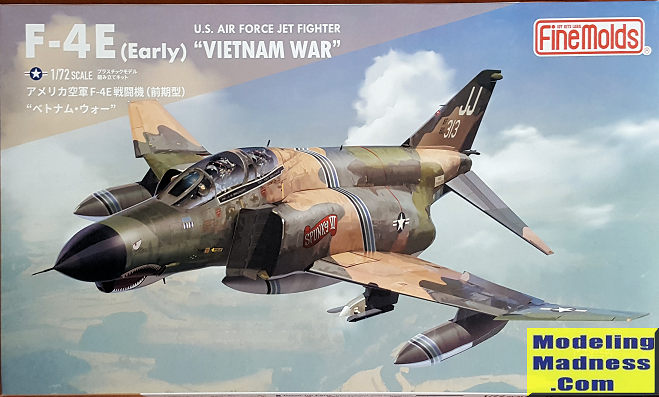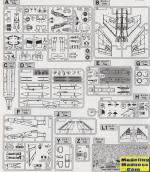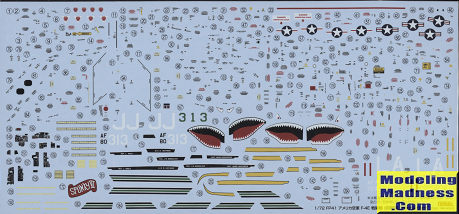
| KIT #: | FP 41 |
| PRICE: | 3900 yen SRP |
| DECALS: | Two Options |
| REVIEWER: | Scott Van Aken |
| NOTES: | 2021 release |

The McDonnell Douglas F-4 Phantom II is an American tandem two-seat, twin-engine, all-weather, long-range supersonic jet interceptor and fighter-bomber originally developed by McDonnell Aircraft for the United States Navy. Proving highly adaptable, it entered service with the Navy in 1961 before it was adopted by the United States Marine Corps and the United States Air Force, and by the mid-1960s it had become a major part of their air arms. Phantom production ran from 1958 to 1981 with a total of 5,195 aircraft built, making it the most produced American supersonic military aircraft in history, and cementing its position as a signature combat aircraft of the Cold War.
The success of the Navy's F-4B and the delays in getting the F-111A into service led the USAF to order the F-4C (originally the F-110A) into production. The aircraft was quite successful leading to the similar F-4D and to the most built variant, the F-4E. This latter aircraft had upgraded avionics and engines, but most of all, was fitted with an internal M61 Vulcan rotary canon. It was this version that also saw fairly widespread foreign use with the type being built by Mitsubishi in Japan. These were some of the longest serving F-4s being finally retired in 2021, though some are still being used as test aircraft. The last USAF F-4E aircraft were retired in the mid-late 1990s.
| THE KIT |
 Fine Molds has turned their expertise to the F-4
Phantom II. This one is an early F-4E which is identified by the shorter gun
muzzle and the unslatted wings. This isn't the only F-4E by far as the type has
been previously kitted by Fujimi and Hasegawa just to name a couple. Those kits are still available and still make nice models. However,
this one has raised the bar in terms of engineering if nothing else.
Fine Molds has turned their expertise to the F-4
Phantom II. This one is an early F-4E which is identified by the shorter gun
muzzle and the unslatted wings. This isn't the only F-4E by far as the type has
been previously kitted by Fujimi and Hasegawa just to name a couple. Those kits are still available and still make nice models. However,
this one has raised the bar in terms of engineering if nothing else.
Here are some of the interesting features. In the cockpit, the side consoles are separate inserts to take into account the various differences between variants. There is full intake trunking back to the first compressor stages. Not surprising is that the forward fuselage is separate. The main fuselage is a single piece with an upper deck insert so no worries about seams. There is also a detail piece for the engine aux intake doors.
Wings are a lower section that includes most of the lower fuselage with upper halves and separate wing tips. There is no folding wing option with this kit. This kit has the 'hard wing' as used by the majority of F-4 variants. The wing underside has inserts for where the cat attachment points would be on the naval versions.
The metal portion of the rear fuselage is a separate item with an insert for the very aft portion. Again, to eliminate some of the usual seams one sees in other kits. You are provided only the fin that is appropriate to the E version. Horizontal stabs are interlocking to help with alignment. The kit provides the correct un-reinforced versions.
Inner main gear doors include a portion of the gear well so attaching these will be a breeze. You are provided missile pylons and three drop tanks. However, there are no weapons, those being offered in a separate weapons pack. There are also no crew members. Finally, you can do canopy open or closed with a separate closed canopy piece.
 Instructions
are excellent with well done drawings and close-up bits to assist with possibly
tricky assembly. Several paint manufacturers are listed, but since pretty much
everything is in Japanese, I cannot tell you which there are. I do see that
Gunze paint numbers are provided. Markings are for two aircraft in standard SEA
camouflage. One is the box art plane with the 34 TFS/388 TFW. I dare say it is
the commander's plane as it has the multi-colored commander's stripes. This
plane does not have the slime lights. The other plane is with the 4th TFS/366th
TFW and does have the slime lights.
Instructions
are excellent with well done drawings and close-up bits to assist with possibly
tricky assembly. Several paint manufacturers are listed, but since pretty much
everything is in Japanese, I cannot tell you which there are. I do see that
Gunze paint numbers are provided. Markings are for two aircraft in standard SEA
camouflage. One is the box art plane with the 34 TFS/388 TFW. I dare say it is
the commander's plane as it has the multi-colored commander's stripes. This
plane does not have the slime lights. The other plane is with the 4th TFS/366th
TFW and does have the slime lights.
Couple of interesting bits of info. First, both these squadrons are still around and with the 388th FW based at Hill AFB Utah. Secondly, slime lights were first installed on planes in 1970-71 with the first production F-4 to wear them being 69-7579. They were quickly retrofit on earlier planes such as the FY 67 and 68 aircraft on this decal sheet. The decals are superbly printed and most of the multitude of stencils are printed in groups.
| CONCLUSIONS |
Since I bought a few of Fine Molds F-4 kits, this one adds to a growing collection. I look forward to the later F-4E and F-4G offerings. Perhaps they will also provide the antennas for an EF-4C or a whole kit, which would be even better.
August 2023 Copyright ModelingMadness.com. All rights reserved. No
reproduction in part or in whole without express permission from the editor. If you would like your product reviewed fairly and fairly quickly, please
contact the editor
or see other details in the
Note to
Contributors.